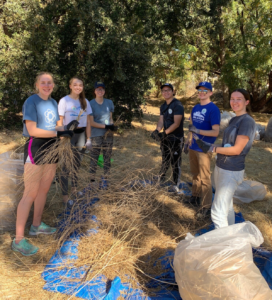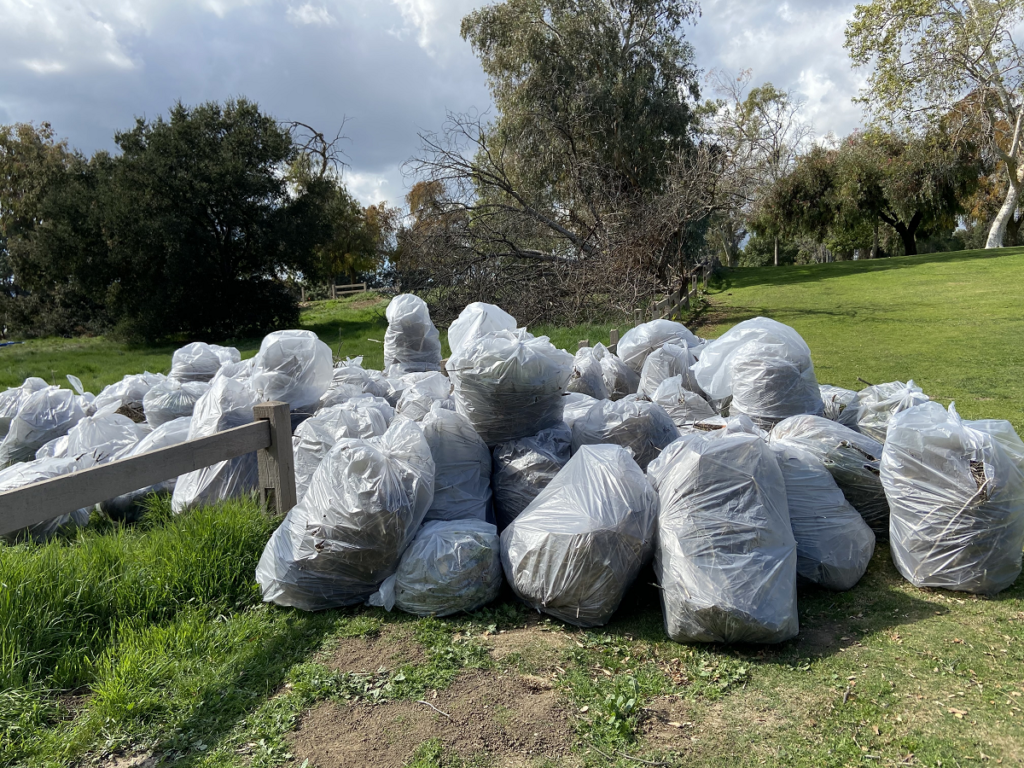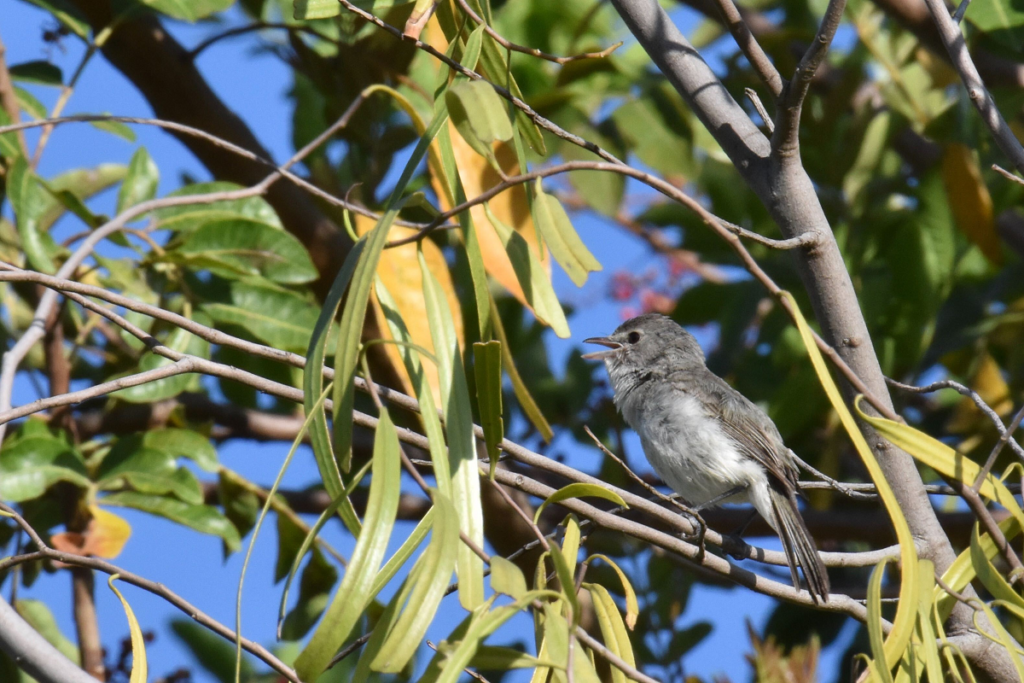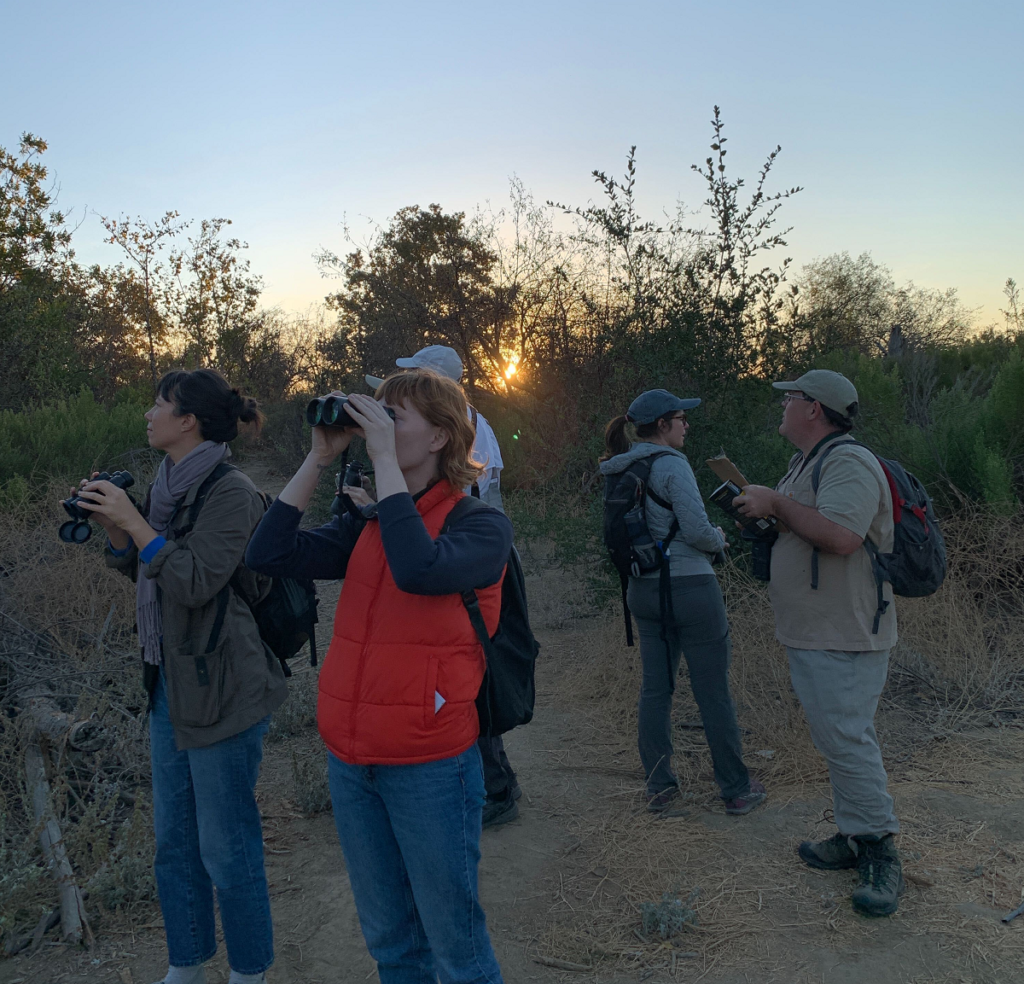
29 May Invasive Plant Removal & Bird Surveys in Sepulveda Basin Wildlife Reserve
The Sepulveda Basin Wildlife Reserve is the only officially designated wildlife area along the Los Angeles River, within the city of Los Angeles. It is a place where birds, plants, and other wildlife are protected, and where humans can escape the busyness of urban life and find respite in nature. The Wildlife Reserve is habitat for more than 200 species of birds that migrate through year round. Endangered species – like the Least Bell’s Vireo – seek refuge in the riparian areas, however invasive plants have limited their habitat in the Reserve. To strengthen our human connection to wildlife, Friends of the LA River (FoLAR) has trained and recruited volunteers to remove invasive plants and survey bird populations to restore habitat in Sepulveda Basin.
Ecological restoration at the reserve is necessary in order to strengthen habitat health in the area which, over time, has been undermined by human activity and non-native, invasive species. Building upon decades of field work, the Santa Monica Chapter of the California Native Plant Society (CNPS), and the San Fernando Valley Audubon Society, and FoLAR earned a Proposition 1 Habitat Restoration grant last year from the Santa Monica Mountains Conservancy to engage volunteers to remove invasive plant species from the Sepulveda Basin Wildlife Reserve. To measure our positive impact on bird life, FoLAR enlisted Tom Ryan at Ryan Ecological Consulting to train volunteers to identify birds by sight and sound, and assist with monthly bird surveys throughout the Reserve. In addition, the Council for Watershed Health is chronicling our community science observations, adding them to their GIS database for the Los Angeles Region. All together, this project re-establishes native vegetation, improves wildlife habitat, reduces fire hazard, and addresses climate change by assisting drought tolerant native plant species.
While this new effort to restore habitat has recruited new volunteers to step up, Sepulveda Basin has long been championed by a number of vital advocacy groups, including the Sepulveda Basin Wildlife Steering Committee – comprised of representatives from non-profit organizations such as the LA/Santa Monica Mountains Chapter of the California Native Plant Society, the San Fernando Valley and LA Audubon Societies, the San Fernando Valley Group of the Sierra Club, the Resource Conservation District of the Santa Monica Mountains, and Friends of the Los Angeles River, as well as the Encino and Lake Balboa Neighborhood Councils.

Volunteers work together to remove invasive mustard plants.
NATIVE BIRDS AND PLANTS HAVE A SYMBIOTIC RELATIONSHIP
Restoration projects to remove invasive plants free up needed space and resources for native plants and birds to thrive in a sustainable habitat. Native plants and native wildlife have a symbiotic relationship, where native birds serve as an indicator of healthy native habitats. For example, Least Bell’s Vireo– a federally endangered bird — nests in dense brush areas of native mule fat or native coyote brush. By restoring the ecological health of the area, we are contributing to the breeding success of this bird and others – birds that live in the area year-round as well as those migrating in both the spring and fall.
There are many different non-native and invasive plants at the Basin that have posed issues to native wildlife year in and out. Annual non-native mustards-like shortpod mustard (Hirschfeldia incana) and black mustard (Brassica nigra) can grow to 6′ tall and create a dense, almost impenetrable thicket. This layer of biomass hides the invasive horehound (Marrubium vulgare). The California Native Plant Society (CNPS) quickly learned that removing the mustard allowed them to find and remove horehound and other invasive weeds such as thistles (Centattrea spp., Carduns spp.), Russian thistle (Salsola sp.), and wild radish (Raphanus sativus). For over 10 years, six to eight volunteers meet on Tuesday and Thursday mornings to remove invasives. Their work has paid off; thanks to a Xerxes Society Pollinator planting grant last fall, 1,600 plant plugs, chosen for their value to pollinating insects, 800 plugs of Narrow-leaf Milkweed (Asclepias fascicularis) and 200 plugs each of: Black Sage (Salvia mellifera); California Goldenrod (Solidago velutina spp californica); Vervaia (Verbena lasiostachys); California Aster, (Symphotrichum Chilense); and 800 plugs of Narrow-leaf Milkweed (Asclepias fascicularis); were planted and are taking root on an acre where invasives have been eradicated.
Restoration efforts associated with this project are made possible by our volunteers. We’ve hosted two Bird Identification Community Science Trainings and recruited over 60 volunteers, including our friends from LA River Conservation Corps. Volunteers were trained on how to identify targeted species such as warblers, sparrows, and hawks to conduct point counts – a method of monitoring birds by tallying birds detected by sight and sound in one location during a specified time period. Prior to the Safer at Home orders, volunteers served as community scientists and carried out data collection in the field. Although volunteers can no longer join us due to the safety guidelines, we continue to monitor the bird population of the area and look forward to when volunteers can rejoin our efforts.
Concurrently, the Council for Watershed Health (CWH) is compiling detailed hydrologic data (lake and small streams), historical aerial photography, and other baseline imagery into the project base map for Sepulveda Basin. Background research was also conducted to determine if detailed vegetation datasets are available for this area. Based on feedback from Tom Ryan and FoLAR, the CWH’s GIS team set up the attribute framework for the bird survey database. Data collected following the October 2019 fire that had occurred within Sepulveda Basin was also digitized from hard copy photography.
VOLUNTEERS LEND A HAND AT HABITAT RESTORATION EVENTS
To date, we have hosted two Habitat Restoration Day volunteer events, in November 2019 and in February 2020, dedicated to removing invasive mustard plants and improving habitat for native plants and birds in the Reserve. We kicked off each event with a morning Bird Walk led by dedicated San Fernando Audubon Society board member, Benny Jacobs-Schwartz. The LA River Rover, our mobile visitor and education center, and several River Docents were present at the events to provide an additional educational experience for our participants.
Our November “work party” took place on an exceptionally warm morning, where over 100 intrepid volunteers joined us. Just a week before the first restoration event, a fire ran through the Basin and burned a total of 60 acres. Thus, by removing dry, invasive mustard plants, this project also reduces the risk of wildfire in the area. On this day, our awesome volunteers succeeded in removing 100 bags of mustard. The November event received significant media coverage by ABC7, KPCC, KTLA, KABC, and KCBS. You can view a published piece by ABC7 here.
In February 2020, we returned for our second restoration event. It was a gloomy morning, but we had 30 energetic volunteers show up. We were able to work quickly and efficiently to remove a total of 80 bags — thanks in part to volunteer Thomas Meehan who figured out an easier way to gather the mustard and dispose of it, using our tarps as funnels!

It takes a village to remove piles of invasive species from our ecosytem.
BIRD SURVEYS ARE STILL UNDERWAY
Due to the safety guidelines implemented in March, volunteers can no longer assist with our surveys but we continue to monitor the bird population of the area. A huge highlight this spring has been the sighting of Least Bell’s vireos who are nesting in the Reserve. Spotting this bird is a hopeful sign worth celebrating, as it indicates strength of native plants to provide habitat for this native bird, who once plentifully bred in and along the LA River. Their riparian woodland habitat has been mostly destroyed due to channelization and urban development. We’ve also recorded many migrant bird species, including Bullock’s Oriole, Warbling Vireo, Townsend’s Warbler, Wilson’s Warbler, and Black-headed Grosbeak. Protecting the vireos’ habitat will not only benefit them but also other species facing similar threats.

A Least Bell’s vireos – an endangered California native bird that lives in woody riparian habitats.
The FoLAR team continues to survey the birds in the area once a month. This data will be integrated with existing data and used to understand how habitat restoration work is improving the health of the ecosystem. Unfortunately, the rapid spread of invasive plants continues to be a threat to the area. Although work associated with this grant will conclude this fall, FoLAR is seeking to continue the restoration work necessary to eradicate the persistent invasive non-native plants in order to improve habitat for people and wildlife. We look forward to sharing the final report with you before the end of the year. Special thanks to: Steve Hartman, George Waddell, Muriel Kotin, Anne Abramson for their assistance and their tireless dedication to the Sepulveda Basin Wildlife Reserve.

Bird Survey volunteers gather at Sepulveda Basin in the early morning in October 2019.

